Input interpretation

BaO barium oxide + N_2O_5 dinitrogen pentoxide ⟶ Ba(NO_3)_2 barium nitrate
Balanced equation
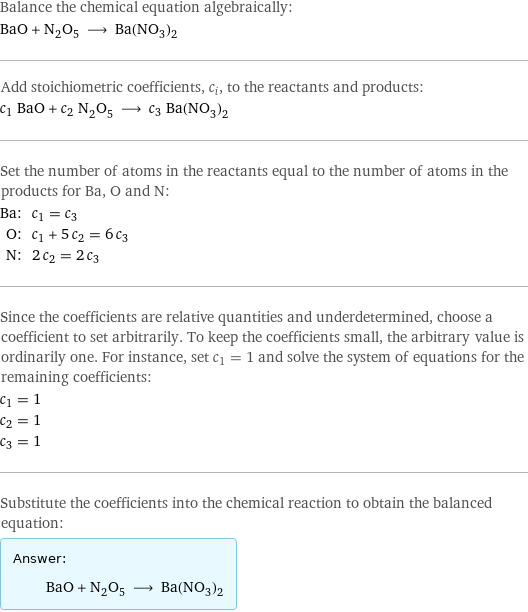
Balance the chemical equation algebraically: BaO + N_2O_5 ⟶ Ba(NO_3)_2 Add stoichiometric coefficients, c_i, to the reactants and products: c_1 BaO + c_2 N_2O_5 ⟶ c_3 Ba(NO_3)_2 Set the number of atoms in the reactants equal to the number of atoms in the products for Ba, O and N: Ba: | c_1 = c_3 O: | c_1 + 5 c_2 = 6 c_3 N: | 2 c_2 = 2 c_3 Since the coefficients are relative quantities and underdetermined, choose a coefficient to set arbitrarily. To keep the coefficients small, the arbitrary value is ordinarily one. For instance, set c_1 = 1 and solve the system of equations for the remaining coefficients: c_1 = 1 c_2 = 1 c_3 = 1 Substitute the coefficients into the chemical reaction to obtain the balanced equation: Answer: | | BaO + N_2O_5 ⟶ Ba(NO_3)_2
Structures
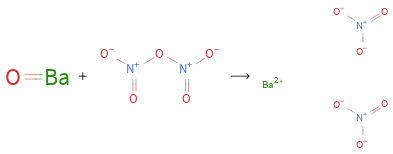
+ ⟶
Names

barium oxide + dinitrogen pentoxide ⟶ barium nitrate
Reaction thermodynamics
Enthalpy
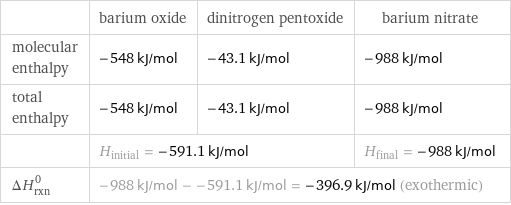
| barium oxide | dinitrogen pentoxide | barium nitrate molecular enthalpy | -548 kJ/mol | -43.1 kJ/mol | -988 kJ/mol total enthalpy | -548 kJ/mol | -43.1 kJ/mol | -988 kJ/mol | H_initial = -591.1 kJ/mol | | H_final = -988 kJ/mol ΔH_rxn^0 | -988 kJ/mol - -591.1 kJ/mol = -396.9 kJ/mol (exothermic) | |
Gibbs free energy
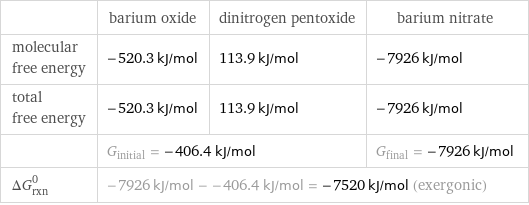
| barium oxide | dinitrogen pentoxide | barium nitrate molecular free energy | -520.3 kJ/mol | 113.9 kJ/mol | -7926 kJ/mol total free energy | -520.3 kJ/mol | 113.9 kJ/mol | -7926 kJ/mol | G_initial = -406.4 kJ/mol | | G_final = -7926 kJ/mol ΔG_rxn^0 | -7926 kJ/mol - -406.4 kJ/mol = -7520 kJ/mol (exergonic) | |
Equilibrium constant
![Construct the equilibrium constant, K, expression for: BaO + N_2O_5 ⟶ Ba(NO_3)_2 Plan: • Balance the chemical equation. • Determine the stoichiometric numbers. • Assemble the activity expression for each chemical species. • Use the activity expressions to build the equilibrium constant expression. Write the balanced chemical equation: BaO + N_2O_5 ⟶ Ba(NO_3)_2 Assign stoichiometric numbers, ν_i, using the stoichiometric coefficients, c_i, from the balanced chemical equation in the following manner: ν_i = -c_i for reactants and ν_i = c_i for products: chemical species | c_i | ν_i BaO | 1 | -1 N_2O_5 | 1 | -1 Ba(NO_3)_2 | 1 | 1 Assemble the activity expressions accounting for the state of matter and ν_i: chemical species | c_i | ν_i | activity expression BaO | 1 | -1 | ([BaO])^(-1) N_2O_5 | 1 | -1 | ([N2O5])^(-1) Ba(NO_3)_2 | 1 | 1 | [Ba(NO3)2] The equilibrium constant symbol in the concentration basis is: K_c Mulitply the activity expressions to arrive at the K_c expression: Answer: | | K_c = ([BaO])^(-1) ([N2O5])^(-1) [Ba(NO3)2] = ([Ba(NO3)2])/([BaO] [N2O5])](../image_source/4dff00f4bd2c5e13b84995a9451c326b.png)
Construct the equilibrium constant, K, expression for: BaO + N_2O_5 ⟶ Ba(NO_3)_2 Plan: • Balance the chemical equation. • Determine the stoichiometric numbers. • Assemble the activity expression for each chemical species. • Use the activity expressions to build the equilibrium constant expression. Write the balanced chemical equation: BaO + N_2O_5 ⟶ Ba(NO_3)_2 Assign stoichiometric numbers, ν_i, using the stoichiometric coefficients, c_i, from the balanced chemical equation in the following manner: ν_i = -c_i for reactants and ν_i = c_i for products: chemical species | c_i | ν_i BaO | 1 | -1 N_2O_5 | 1 | -1 Ba(NO_3)_2 | 1 | 1 Assemble the activity expressions accounting for the state of matter and ν_i: chemical species | c_i | ν_i | activity expression BaO | 1 | -1 | ([BaO])^(-1) N_2O_5 | 1 | -1 | ([N2O5])^(-1) Ba(NO_3)_2 | 1 | 1 | [Ba(NO3)2] The equilibrium constant symbol in the concentration basis is: K_c Mulitply the activity expressions to arrive at the K_c expression: Answer: | | K_c = ([BaO])^(-1) ([N2O5])^(-1) [Ba(NO3)2] = ([Ba(NO3)2])/([BaO] [N2O5])
Rate of reaction
![Construct the rate of reaction expression for: BaO + N_2O_5 ⟶ Ba(NO_3)_2 Plan: • Balance the chemical equation. • Determine the stoichiometric numbers. • Assemble the rate term for each chemical species. • Write the rate of reaction expression. Write the balanced chemical equation: BaO + N_2O_5 ⟶ Ba(NO_3)_2 Assign stoichiometric numbers, ν_i, using the stoichiometric coefficients, c_i, from the balanced chemical equation in the following manner: ν_i = -c_i for reactants and ν_i = c_i for products: chemical species | c_i | ν_i BaO | 1 | -1 N_2O_5 | 1 | -1 Ba(NO_3)_2 | 1 | 1 The rate term for each chemical species, B_i, is 1/ν_i(Δ[B_i])/(Δt) where [B_i] is the amount concentration and t is time: chemical species | c_i | ν_i | rate term BaO | 1 | -1 | -(Δ[BaO])/(Δt) N_2O_5 | 1 | -1 | -(Δ[N2O5])/(Δt) Ba(NO_3)_2 | 1 | 1 | (Δ[Ba(NO3)2])/(Δt) (for infinitesimal rate of change, replace Δ with d) Set the rate terms equal to each other to arrive at the rate expression: Answer: | | rate = -(Δ[BaO])/(Δt) = -(Δ[N2O5])/(Δt) = (Δ[Ba(NO3)2])/(Δt) (assuming constant volume and no accumulation of intermediates or side products)](../image_source/abb59aae6dcbca65dcdb204d12c16802.png)
Construct the rate of reaction expression for: BaO + N_2O_5 ⟶ Ba(NO_3)_2 Plan: • Balance the chemical equation. • Determine the stoichiometric numbers. • Assemble the rate term for each chemical species. • Write the rate of reaction expression. Write the balanced chemical equation: BaO + N_2O_5 ⟶ Ba(NO_3)_2 Assign stoichiometric numbers, ν_i, using the stoichiometric coefficients, c_i, from the balanced chemical equation in the following manner: ν_i = -c_i for reactants and ν_i = c_i for products: chemical species | c_i | ν_i BaO | 1 | -1 N_2O_5 | 1 | -1 Ba(NO_3)_2 | 1 | 1 The rate term for each chemical species, B_i, is 1/ν_i(Δ[B_i])/(Δt) where [B_i] is the amount concentration and t is time: chemical species | c_i | ν_i | rate term BaO | 1 | -1 | -(Δ[BaO])/(Δt) N_2O_5 | 1 | -1 | -(Δ[N2O5])/(Δt) Ba(NO_3)_2 | 1 | 1 | (Δ[Ba(NO3)2])/(Δt) (for infinitesimal rate of change, replace Δ with d) Set the rate terms equal to each other to arrive at the rate expression: Answer: | | rate = -(Δ[BaO])/(Δt) = -(Δ[N2O5])/(Δt) = (Δ[Ba(NO3)2])/(Δt) (assuming constant volume and no accumulation of intermediates or side products)
Chemical names and formulas
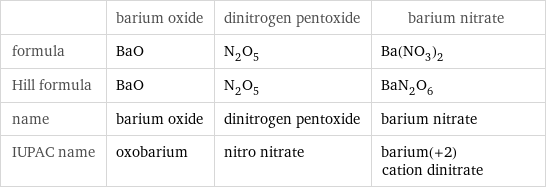
| barium oxide | dinitrogen pentoxide | barium nitrate formula | BaO | N_2O_5 | Ba(NO_3)_2 Hill formula | BaO | N_2O_5 | BaN_2O_6 name | barium oxide | dinitrogen pentoxide | barium nitrate IUPAC name | oxobarium | nitro nitrate | barium(+2) cation dinitrate
Substance properties
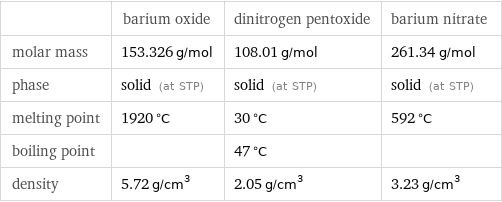
| barium oxide | dinitrogen pentoxide | barium nitrate molar mass | 153.326 g/mol | 108.01 g/mol | 261.34 g/mol phase | solid (at STP) | solid (at STP) | solid (at STP) melting point | 1920 °C | 30 °C | 592 °C boiling point | | 47 °C | density | 5.72 g/cm^3 | 2.05 g/cm^3 | 3.23 g/cm^3
Units
